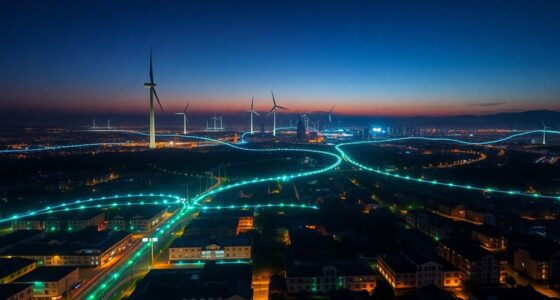Carbon capture technology traps carbon dioxide emissions from industrial sources or power plants before they reach the atmosphere. It involves using advanced materials and processes to extract CO2, which can then be stored underground or used elsewhere. While promising for slowing climate change, it faces challenges like high costs and technical hurdles. If you’re curious about how this innovative tech works and its potential impact, keep exploring to uncover more about its role in fighting climate change.
Key Takeaways
- Carbon capture involves trapping CO2 emissions from industrial sources before they reach the atmosphere.
- It uses advanced materials and processes to separate CO2 from gases, making storage or reuse possible.
- Captured CO2 can be stored underground or repurposed, helping reduce greenhouse gases contributing to climate change.
- Despite promising potential, high costs and energy requirements are major challenges to widespread adoption.
- Continued innovation, investment, and policy support are crucial to scaling up this technology to effectively slow climate change.

As the world grapples with climate change, carbon capture technology offers a promising way to reduce greenhouse gas emissions. This innovative approach involves trapping CO2 emissions from industrial processes or power plants before they reach the atmosphere, then either storing it underground or repurposing it for other uses. While the concept sounds straightforward, implementing it at scale presents a mix of challenges, especially around cost efficiency and technological hurdles.
One of the biggest obstacles is making carbon capture economically viable. Currently, the cost efficiency of capturing and storing CO2 remains high, which discourages widespread adoption. The process requires significant energy input, often increasing operational costs and reducing overall efficiency. For many companies, these expenses can outweigh the benefits, especially when there’s no immediate financial incentive or regulatory pressure. To overcome this, researchers are exploring ways to optimize existing technologies and develop new methods that lower costs. Innovations like solvent and sorbent materials aim to make capturing CO2 less energy-intensive, but these solutions are still in development stages and not yet ready for large-scale deployment.
Technological challenges also play a critical role in shaping the future of carbon capture. For instance, capturing CO2 from dilute sources like ambient air or diffuse emissions from transportation is far more complex than from concentrated industrial sources. Developing systems that can efficiently extract CO2 in these contexts requires breakthroughs in material science and process engineering. Additionally, safely storing the captured CO2 over long periods presents its own set of risks and uncertainties. Researchers must ensure that underground storage sites are secure and that there’s no leakage, which adds layers of technical complexity and regulatory oversight.
Despite these hurdles, progress is steady. Pilot projects and early commercial deployments demonstrate that, with targeted investment and technological advancements, the costs can be brought down, and efficiencies improved. Governments and private companies are increasingly recognizing the importance of carbon capture as part of a holistic climate strategy, which can help accelerate innovation and scale-up efforts. The key lies in continued research, policy support, and investment to tackle both the economic and technological challenges head-on. If these issues are addressed, carbon capture technology could become a crucial tool in our fight against climate change, helping us reduce emissions without sacrificing economic growth or energy reliability. Expanding the use of top-performing projectors for visualization and monitoring can also aid in understanding the impacts of different approaches and optimizing solutions.
Frequently Asked Questions
How Much Does Carbon Capture Technology Cost to Implement at Scale?
The cost of implementing carbon capture technology at scale varies, but a thorough cost analysis shows it can be expensive initially. You’ll need to evaluate infrastructure investments, operational expenses, and maintenance costs. Despite high upfront costs, many experts believe the economic feasibility improves as technology advances and scales up, making it a potentially essential tool in reducing emissions. Ultimately, balancing costs and benefits is key to appraising its long-term viability.
What Are the Potential Environmental Risks of Carbon Storage?
Imagine a hidden danger lurking beneath the surface as you consider carbon storage. There’s a risk that leaks could harm marine ecosystems or cause groundwater contamination, threatening delicate balances and human water supplies. These environmental risks are subtle but severe, and if not managed carefully, they could undermine climate efforts. You need to weigh these potential impacts against the benefits, staying vigilant to protect our planet’s fragile ecosystems.
Can Carbon Capture Be Applied to Existing Power Plants Easily?
You can apply carbon capture to existing power plants, but retrofit challenges can be significant. It requires installing new equipment, which may disrupt operations and reduce efficiencies initially. Upgrading older facilities demands careful planning to balance costs and maintain operational efficiencies. While technically feasible, you’ll need to take these challenges into account to ensure the retrofit is successful and sustainable in the long run.
How Long Can Captured Carbon Be Stored Underground Safely?
Sure, you’re probably wondering how long captured carbon can sit underground without throwing a party. Well, with proper geological stability and advanced monitoring technologies, it can stay safely stored for thousands of years. Think of it as a long-term guest who’s well-behaved, thanks to careful site selection and constant oversight. So, with diligent management, underground storage can be both safe and effective for the foreseeable future.
What Advancements Are Needed to Make Carbon Capture More Efficient?
To make carbon capture more efficient, you need technological innovations that improve capture rates and reduce costs. Advances like better sorbents and direct air capture systems are essential. Additionally, policy incentives encourage research and deployment, making the technology more accessible. By supporting these innovations and policies, you help accelerate progress toward scalable, effective carbon capture solutions that can markedly slow climate change.
Conclusion
By now, you can see how carbon capture technology could be a game-changer in fighting climate change. Did you know that capturing just 1% of global CO2 emissions could prevent billions of tons from entering the atmosphere? That’s like taking millions of cars off the road each year. As you stay informed, remember that supporting or investing in these innovations can make a real difference in creating a sustainable future for everyone.









